
- Category: grade
- Growth type: indeterminate
- Appointment: fresh consumption
- Ripening period: mid-season
- Ripening time, days: 110-120
- Growing conditions: for greenhouses
- Bush size: tall
- Bush height, cm: 160-180
- Leaves: long, drooping
- Ripe fruit color: yellow-orange
Mango Django is a completely new yellow-fruited tomato variety, which, due to its unusual fruits, has already become almost collectible. Due to the rarity of the culture, there is little practice of application in domestic gardens, but little experience in cultivation appears. And the tomato is interesting not only for its shape, but also for its special taste. And despite the fact that the variety is not included in the lists of the State Register, it enjoys a certain popularity.
Description of the variety
A mid-season, indeterminate variety is tall, actively growing, plants can reach a height of 160 to 180 centimeters. Leaves of a characteristic drooping shape bloom on the bushes, while they are quite long. At the same time, the culture is distinguished by a simple structure of brushes, on which from 5 to 7 tomatoes are tied. We also note other features of the variety that can be ranked among its merits:
- decorative form of fruits, as well as their bright color;
- taste inherent in yellow tomatoes;
- aroma of pulp;
- high germination rates and rapid development of seedlings;
- excellent yield.
Consider the cons, but there are not many of them.
- Heat-loving variety. Most often, tomatoes are grown in greenhouses. It will be possible to cultivate in open beds only in the south.
- Narrow use. Mostly tasty fruits are eaten fresh in salads and other dishes. They are not suitable for processing and canning.
- The need to form bushes.
- Difficulties in obtaining seeds, since there are few of them in the fruits.
The main qualities of the fruit
Tomatoes of the Mango Django variety have an original elongated-oval shape, at the top of which there is a small sharp nose. The shape is not similar to any other tomato. Their color is also different - when biological ripeness comes, the tomatoes become yellow-orange, beautiful and shiny. By weight, they are slightly heavier than average, 250-260 grams.
Taste characteristics
Mango Django also has orange pulp, it is tender, sweetish, the characteristic sourness is completely absent, the tomato has an almost tropical taste. Seed chambers are practically absent. The tomato is a solid, succulent and juicy pulp.
Since the purpose of tomatoes is dessert, and this variety is characterized by a high content of sugar and carotene, vegetables are used in baby and diet food, and they can also be used by people suffering from an allergic reaction to tomatoes and problems with gastrointestinal acidity.
Ripening and fruiting
Mid-season variety - 110-120 days pass from the first shoots to the appearance of beautiful fruits.
Yield
With proper care, fruit yield can reach up to 5 kg per plant.
The timing of planting seedlings and planting in the ground
Sowing of Mango Django seeds for seedlings occurs in March-April. May, the last days - the period of planting already grown seedlings in the ground.

Growing tomato seedlings is an extremely important process, because it largely depends on whether the gardener will be able to harvest at all. All aspects must be taken into account, from seedbed preparation to planting in the ground.
Landing scheme
The bushes are planted at a distance of 50 by 60 cm so that nothing interferes with the development of each plant.

Growing and care
In the process of planting a seedling in each hole, you need to put a mix of 1 tbsp. l. superphosphate and potassium sulfate. During the growing season of tomatoes, it is recommended to water them only if there is strong dry weather.
If the cultivation is greenhouse, the bushes are formed into one or two trunks, and 4 to 5 fruiting brushes should be left on each stem. When the berries begin to form, root feeding with magnesium sulfate will be necessary. Do not forget to pick off old foliage during the ripening of tomatoes. And also a garter to the support and pinning is required.




A plant needs different micronutrients at each stage of growth. All fertilizers can be divided into two groups: mineral and organic. Folk remedies are often used: iodine, yeast, bird droppings, eggshells.
It is important to observe the rate and period of feeding. This also applies to folk remedies and organic fertilizers.



























































































